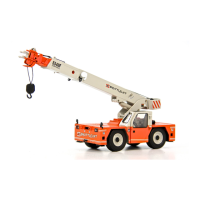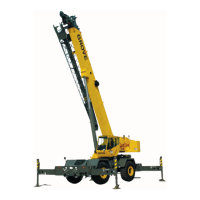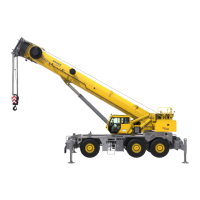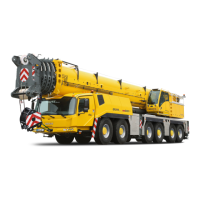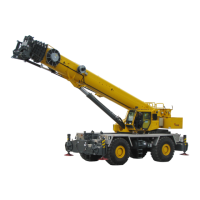ENGINE AND ENGINE SYSTEMS CD3340B/YB4411
6-6
Published 04/07/2015 Control # 569-00
REMOVAL AND INSTALLATION
Removal
1. Either block all four tires or lower the outriggers to inhibit
movement during engine removal.
2. Remove the engine cover.
3. Disconnect the battery ground cable from the
transmission mounting bolt. Remove the battery cable
from the engine starter.
4. Disconnect the frame electrical wire harness from the
engine electrical wire harness.
5. Tag all wires that are connected to the transmission.
Disconnect all wires from the transmission
6. Drain the radiator. Disconnect the upper and lower
hoses from the radiator.
7. Disconnect the transmission cooling lines from the
radiator. Put plugs and caps on all lines to keep dirt out
of the system.
8. Remove the radiator.
9. Remove the air cleaner and intake hose(s).
NOTE: Have a fire extinguisher handy and know how to
use it before performing the next step.
10. Disconnect the fuel lines from the engine. Plug or cap
the lines to prevent leakage.
11. If equipped, disconnect the heater hoses from the
engine.
12. Drain the hydraulic oil tank. Disconnect all hydraulic
lines from the hydraulic pumps. See SECTION 4.
13. Disconnect the drive shaft from the transmission. See
SECTION 8.
14. Disconnect the exhaust pipe from the exhaust manifold
of the engine.
Lack of power.
1. Engine overload.
2. Intake air restriction.
3. Clogged fuel filters.
4. Overheated engine.
5. Below normal engine temperature.
6. Faulty engine.
1. Reduce the load.
2. Service air cleaner.
3. Replace fuel filters.
4. See Engine Operators Manual. Check for
plugged radiator/oil cooler fins.
5. Remove and check thermostat.
6. See Engine Operator’s Manual.
Low oil pressure.
1. Low oil level.
2. Faulty gauge or sender.
3. Improper type of oil.
1. Add oil.
2. Check gauge, sender and connections.
3. Drain and fill crankcase with proper viscosity
and quality.
Engine overheats.
1. Engine overloaded.
2. Low coolant level.
3. Plugged radiator/coolant fins.
4. Faulty radiator cap.
5. Cooling system needs flushing.
6. Defective thermostat.
7. Defective temperature gauge or
sender.
1.
Reduce the load.
2. Fill radiator to proper level, check radiator and
hose for
loose connections o
r leaks.
3. Clean fins.
4. Replace the radiator cap.
5. Flush cooling system.
6. Replace the thermostat.
7. Check and replace.
Problem Probable Cause Action
DANGER
A raised and badly supported machine can fall on you
causing severe injury or death. Position the machine on a
firm, level surface before raising one end. Ensure that the
other end is securely chocked. DO NOT rely solely on the
machine hydraulics or outriggers to support the machine
when working under it.
Reference Only
